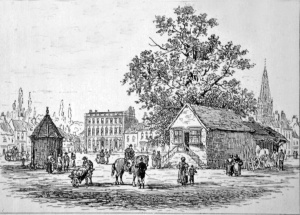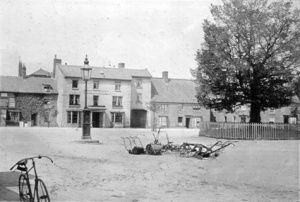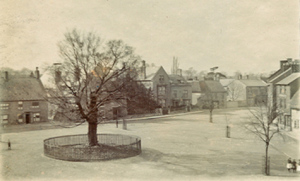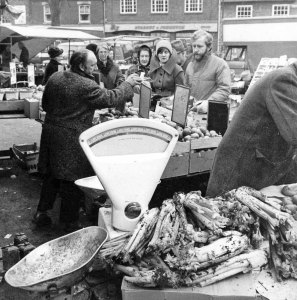
Sketch from an old print of Olney Market Place in William Cowper’s time
The Market Place – the reason for Olney’s status as a town – has always been the hub and centre of its life. Olney does not have a Market Charter, instead it has a ‘prescriptive’ market, one founded on ancient custom and viewed as an authoritative claim established by long use. The first records of Olney Market date from 1205-6.
Olney’s market was held each Monday until the mid 18th century but during the second half of the 19th century it fell into decline. Later the market was held fortnightly on Thursdays, and the Cattle Market revived and held again on Mondays. The general market is still held on Thursdays, but the last cattle market was held in April 1987 and the last Fat Stock Show took place in 1986.
Originally the Lord of the Manor received the rents from the Market, but when part of Olney Court Estate was sold in 1941, Lot 6, entitled ‘Manorial Rights of Fair and Market belonging to the Manor of Olney’ was acquired by the then Parish Council.

Pump and lamp 1890s
Two Fairs were held annually in Olney, the Cherry Fair on 29th June and the Statute Fair on 13th October. The latter was probably the usual autumn hiring fair held in country districts when workers could put themselves up for hire. Prospective employers, each distinguished by a badge of office worn in his cap, came to view the various workers either on the Market Place or at an Inn, such as the Bull. The Cherry Fair coincided with the Church’s Patronal Festival. Holy Days were the only ‘holidays’ workers had, so a licence was granted to the Lord of the Manor in 1316 to hold a Cherry Fair ‘for the vigil, feast and morrow of St. Peter and St. Paul’. It was designated a ‘Cherry Fair’ so that the fruit from the many orchards around medieval Olney could be sold off quickly. The Fair was originally held on the Market Place and later in the Fair Field off East Street. Concerts and meetings were also held on the Market Place, it being the ideal gathering place for the townsfolk.
In the 18th century, the Kettering to London Turnpike road ran along the western side of the Market Place while the southern side was known as ‘The Parade’.
Olney’s triangular Market Place, sometimes wrongly called ‘Square’ and even ‘Hill’, was resurfaced around 1780, thanks to the generosity of Daniel Raban, a baker. William Cowper, the poet who lived for 19 years in a house overlooking the Market Place records the resurfacing in one of his letters to John Newton dated February 1782.
‘Daniel Raban (baker) has levelled and gravelled the Market Hill, and because water is scarce at Olney, has put the parish to the expense of a town pump, and designs, in order that people may not run their heads against it in the night, to crown it with a lamp. As the people here are not so rich as to be able to afford superfluities, this measure does not give universal satisfaction. I subjoin the only verses I have written for some time, which, however, are not to be published. The pump stands opposite Banister’s door.’
Let Banister now lend his aid
to furnish shoes for the Baker,
Who has put down a pump,
with a lamp on its head,
For the use of the said Shoe-maker.

The Linden trees together with the last, storm damaged, Elm tree 1890s
At the beginning the of 19th century there were three significant ‘features’ on the Market Place itself. The above quoted letter from Newton gives the history of one – the Parish Pump – which survived into the 1960’s but was removed when the Market Place was resurfaced. The pump is now in the Museum Yard.
Another feature was the Shiel Hall, a two storied building, the upper part of which was reached at the northern end, by a double flight of steps. A blacksmith’s forge occupied the southern end. The building was used as a ‘town hall’ and a school, which was run by the eccentric Samuel Teedon. The Shiel Hall was taken down around 1816.
To the east of the Shiel Hall was the third significant building, the Round House or Lock Up, a small hexagonal building. The distance from the Round House to the High Arch (near the United Reformed Church) was the ancient whipping distance in Olney. The Round House was taken down about 1846 and re-erected for a short time further down the High Street. All that remains today is the stone ball that topped it, which is now in the Museum Yard.

After re-surfacing the market began to re-establish itself in the 1960s
Originally there were three elm trees on the Market Place, said to commemorate the union of the three kingdoms (England, Scotland and Ireland) in the reign of James the First. Under them stood the stocks. One tree disappeared before 1800, another was blown down about 1832, and the third was damaged by a bad storm on 4 July 1884 but recovered and continued to flourish until around the end of the nineteen forties. Seven Linden trees were planted around the Market Place during the late 1800s to compensate for the eventual demise of the elm tree.
In more recent times, Tom Garner (draper) left a thousand pounds in his will towards the resurfacing of the Market Place, which was completed in the early 1960’s. This improvement was the salvation of the modern market, resurrecting it from two stalls to, often, a waiting list of traders wanting a pitch on Olney’s Thursday Market.
Today, the Thursday Market remains well attended and relatively stable in terms of the number of stalls and the variety of produce and goods available. In addition, the Sunday Farmers Market held on the first Sunday in each month, appears to be expanding and doing brisk business.
.
.
Return to Introduction to the Market Place tour
Copyright © 2013 Olney & District Historical Society
